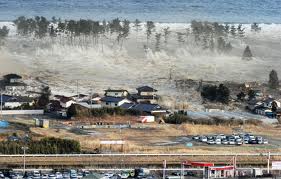
 In the early 1990s the author of this essay observed a curious phenomenon. He was observing two scuba divers who had descended below a Southern California bay to effect repairs on a submerged mooring system. The previous night a powerful winter storm had passed through, leaving strong residual winds in its wake. The waves the winds created were well formed and from peak to trough, were about two to three feet in height.
In the early 1990s the author of this essay observed a curious phenomenon. He was observing two scuba divers who had descended below a Southern California bay to effect repairs on a submerged mooring system. The previous night a powerful winter storm had passed through, leaving strong residual winds in its wake. The waves the winds created were well formed and from peak to trough, were about two to three feet in height.As the waves entered the region of the rising air bubbles, the section of wave passing over the bubbles mysteriously disappeared. On closer inspection it was determined that the wave wasn’t being physically forced or knocked down, they were simply being "diminished" to such a degree as to become essentially "non existent". Within three feet of entry into the bubbled region, all waters immediately beyond were rendered relatively flat and calm. A condition that spread out in a 45 degree "V" pattern, until the adjacent parts of the wave looped around to reform into an integrated wavefront some fifty or more yards away.
Thinking this might have patent possibilities, the author conducted an on-line patent search only to discover that the principle he observed that cold and blustery day, had been discovered and patented many years before.
“Collapsing” The Largest of Waves
Between 1906 and 1947 an American inventor named Phillip Brasher received four U.S. Patents(1) all based on the same principle, wave destruction. All operated by the sub-surface insertion of "air bubbles" into the path of oncoming ocean waves.
Though powerful, ocean waves are quite gingerly balanced. Since water is essentially incompressible, the introduction of a compressible fluid such as air or other gases, can alter the dynamics of a wave to such a degree, that it is claimed to be able to "collapse" even the largest of waves. Indeed, a wave destroyer based on Mr. Brashers invention was actually used to save a large concrete peer, during a time of fierce wave activity in El Segundo California in the 1960s.
Had equipment based on Mr. Brashers invention been deployed previous to recent events in Japan, it could have reduced if not completely prevented the unfortunate havoc visited there in recent days. Though the equipment required in the Brasher patents is relatively simple, it is still of a mechanical nature with a propensity for failure, exponentially equivalent to the number of its parts.
Remember, in Japan the Tsunami hit only nine minutes after the quake, begging the question: Could mechanical equipment, operating in a harsh salty environment for possibly decades with only occasional maintenance be relied upon? The ideal would be something "simple". Something that could reside "in place" for decades, before suddenly being required to reliably operate at peak efficiency, with only a moments notice.
Compliance Bags
It is with the foregoing in mind that the author of this essay conceived and proposes a new variation on Mr. Brashers worthy discovery. It involves the sub-surface placement of multiple air-filled "Compliance Bags" made of tough, resilient material. The bags would be ballasted and/or anchored in place, thus standing guard continuously to "prevent" the development of Tsunamis and Tidal waves.
Computer modeling may reveal that the flexible "geometries" of bag deployment results in a more efficient operation, then the release of air in a linear fashion (horizontal lines) with regard to a wave front. Indeed, a wave front may actually approach at a different angle then straight on, rendering sub-surface piping/compressor type equipment inefficient, even useless.
Further, deployment farther out at sea, where mechanical equipment might be prohibitive, may be a more environmentally effective approach. This would allow bags to be positioned at greater depths to maximally impinge on approaching Tsunamis, while minimally affecting the daily (environmental) effects of normal surface waves. On that same note; Compliance bags, which would probably be great in number, could possibly be fashioned and deployed in a manner that would create vast, new aquatic habitat (fisheries) for marine life, especially during earlier spawning and developmental stages.
(1)
P. Brasher – Patent # 843926 – Nov 22, 1906 – “Protecting Objects From Wave Action”
P. Brasher – Patent # 1391992 – Sep 11, 1920 – “Protecting Objects From Wave Action”
P. Brasher – Patent # 1716616 – Jul 22, 1927 – “Apparatus For Use In Connection With Water Waves”
P. Brasher – Patent # 2492949 – Feb 20, 1947 – “Apparatus For Collapsing Water Waves”
Note:
1) This essay may contain entirely new concepts regarding "wave destruction" that may constitute intellectual property of a patentable nature. The author hereby reserves all rights and;
2) All intellectual property/patent rights that may be upheld or otherwise accrue to the author (owner) are hereby relinquished to the Public Domain.
© M. J. Sperry – March 23, 2011 – – All rights to this work are released to the Public Domain, but only if reprinted in its entirety including disclaimers. Please distribute widely.

Be the first to comment